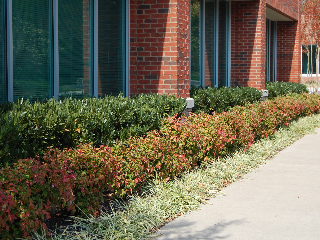
Dwarf varieties can fill a big space in your landscape management plan. Let’s look at some instances when we will definitely be better off putting the little guys into the game rather than calling on their big brothers.
How about fruit trees in your home landscape? Let’s say you want to start a small home orchard consisting of several different types of fruit trees, but you just don’t have a lot of acreage to work with. If you plant standard size fruit trees, just one or two at the most will overrun your allotted space.
This is the perfect opportunity to plug in the little guys. Some fruit tree companies even offer package deals of several different kinds of dwarf fruit trees to be ordered, shipped, and planted together in a small space. It’s also easier and safer (no ladder!) to pick the mature fruit from smaller size dwarf trees than from the taller standard size trees.
What about flowers? You bet. Dwarf varieties exist for many of the summer flowering annuals as well as for many of the bulbs.
Beautiful long stemmed tulips that produce giant blooms have their place in the garden, but it’s nice to offset these or to create a layered effect by bordering them with some of the smaller and shorter stemmed dwarf varieties.
On to my favorite use of dwarf varieties in the landscape—dwarf evergreen landscaping shrubs. Why do I like these so much? It’s because when you’re planting these, you’re building (let’s even be bold and say “creating”) a living, growing, well-sculpted and shaped garden structure that’s as close to permanent as anything you’ll conjure up and install into your landscaping scheme. AND—the dwarf varieties require almost (drum roll, please…..) no maintenance!
In fewer words—I like to plant the dwarf evergreens into the landscape because you have year-round greenery (sometimes reddery!) that you don’t have to constantly prune.
Dwarf varieties are often available at your local garden center for some of the hollies (dwarf Burford is nice) and for some of the boxwoods. Also, dwarf nandina (Firepower is a good variety) can usually be found in a well-stocked nursery or garden center.
I mention the dwarf hollies and boxwoods because of the compact and especially dense nature of the branches and the leaves—even though the plants are small, their denseness makes them highly visible and well-anchored into the overall landscape planting.
The foliage of the dwarf nandinas is a bit more loose and leafy (softer) but still dense enough to demand a well-defined area in the landscape.
How should we incorporate these dwarf evergreen shrubs into our plans? There are quite a few different ways.
One method is to use them as border plants along the walkway or driveway or at the edge of a larger landscaped area—almost like a small hedge except that they don’t require constant pruning like privet hedges.
Or—group the dwarfs together into a flowing cluster of green to define or shape certain areas within a larger mulched area.
For foundation plantings, use the dwarfs in the lower front area (like we did for the flowers) as you move back closer to the building and install taller plants, allowing the dwarfs to show-off their contrasting texture, color, shape, density, and (especially) height.
By now, you get the idea—small evergreen plants that need little maintenance. And, as winter arrives, if you’ve incorporated some of the dwarf nandina into your landscape, you’ll even see some of the pretty evergreen leaves take on beautiful shades of red in the coolness of the season. (That was the part about the “reddery” that we mentioned earlier!!).
 Dwarf varieties can fill a big space in your landscape management plan. Let’s look at some instances when we will definitely be better off putting the little guys into the game rather than calling on their big brothers.
Dwarf varieties can fill a big space in your landscape management plan. Let’s look at some instances when we will definitely be better off putting the little guys into the game rather than calling on their big brothers.